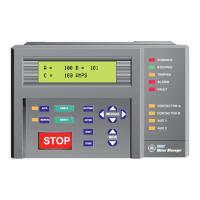GE Power Management
MM2 Motor Manager 2 E-1
APPENDIX E E.1 CT ISOLATION
E
APPENDIX E CT ISOLATIONE.1 CT ISOLATION E.1.1 MM2 CT WITHSTAND
When is withstand important?
Withstand is important when the phase or ground CT has the capability of driving a large amount of
current into the interposing CTs in the relay. This typically occurs on retrofit installations when the
CTs are not sized to the burden of the relay. New electronic relays have typically low burdens, while
the older electromechanical relays have typically high burdens (e.g. 1
Ω
).
For high current ground faults, the system will be either low resistance or solidly grounded. The limit-
ing factor that determines the amount of ground fault current that can flow in these types of systems
is the capacity of the source. Withstand is not important for ground fault on high resistance grounded
systems. On these systems, a resistor makes the connection from source to ground at the source
(generator, transformer). The resistor value is chosen such that in the event of a ground fault, the
current that flows is limited to a low value, typically 5, 10, or 20 A.
Since the potential for very large faults exists (ground faults on high resistance grounded systems
excluded), the fault must be cleared as quickly as possible.
Care must he taken to ensure that the interrupting device is capable of interrupting
the potential fault. If not, some other method of interrupting the fault should be used,
and the feature in question should be disabled (e.g. a fused contactor relies on fuses
to interrupt large faults).
E.1.2 CT SIZE AND SATURATION
How do I know how much current my CTs can output?
CT characteristics may be acquired by one of two methods.
The rating (as per ANSI/IEEE C57.13.1) for relaying class CTs may be given in a format such as
these: 2.5C100, 10T200, T1OO, 10C50, or C200. The number preceding the letter represents the
maximum ratio correction; no number in this position implies that the CT accuracy remains within a
10% ratio correction from 0 to 20 times rating. The letter is an indication of the CT type. A 'C' (for-
merly L) represents a CT with a low leakage flux in the core where there is no appreciable effect on
the ratio when used within the limits dictated by the class and rating. The 'C' stands for calculated;
the actual ratio correction should be different from the calculated ratio correction by no more than
1%. A 'C' type CT is typically a bushing, window, or bar type CT with uniformly distributed windings.
A 'T' (formerly H) represents a CT with a high leakage flux in the core where there is significant effect
on CT performance. The 'T' stands for test; since the ratio correction is unpredictable, it is to be
determined by test. A 'T' type CT is typically primary wound with unevenly distributed windings. The
subsequent number specifies the secondary terminal voltage that may be delivered by the full
winding at 20 times rated secondary current without exceeding the ratio correction specified by the
first number of the rating. (Example: a 10C100 can develop 100 V at 20
×
5A, therefore an appropri-
ate external burden would be 1
Ω
or less to allow 20 times rated secondary current with less than
10% ratio correction). Note that the voltage rating is at the secondary terminals of the CT and the
internal voltage drop across the secondary resistance must be accounted for in the design of the CT.
There are seven voltage ratings: 10, 20, 50, 100, 200, 400, and 800. If a CT comes close to a higher
rating, but does not meet or exceed it, then the CT must be rated to the lower value.
NOTE

